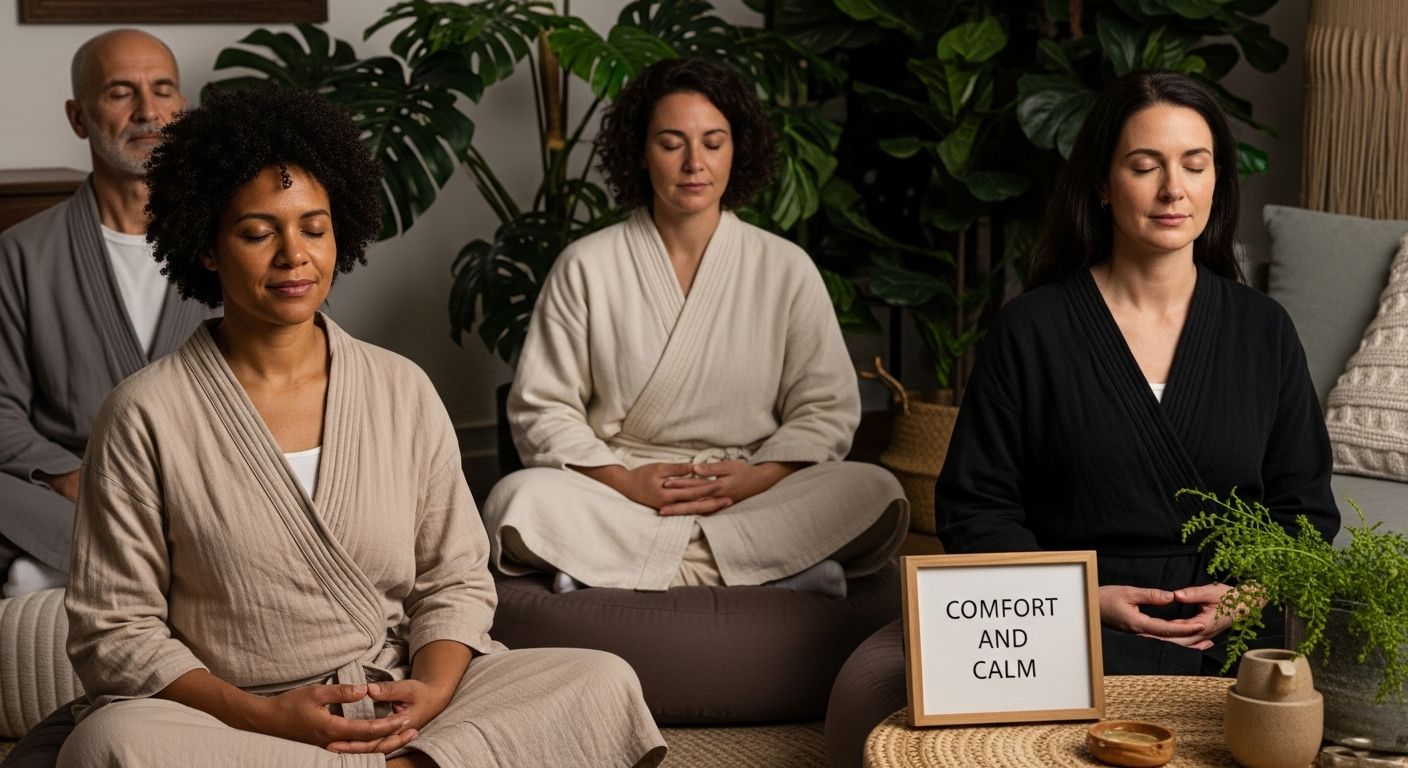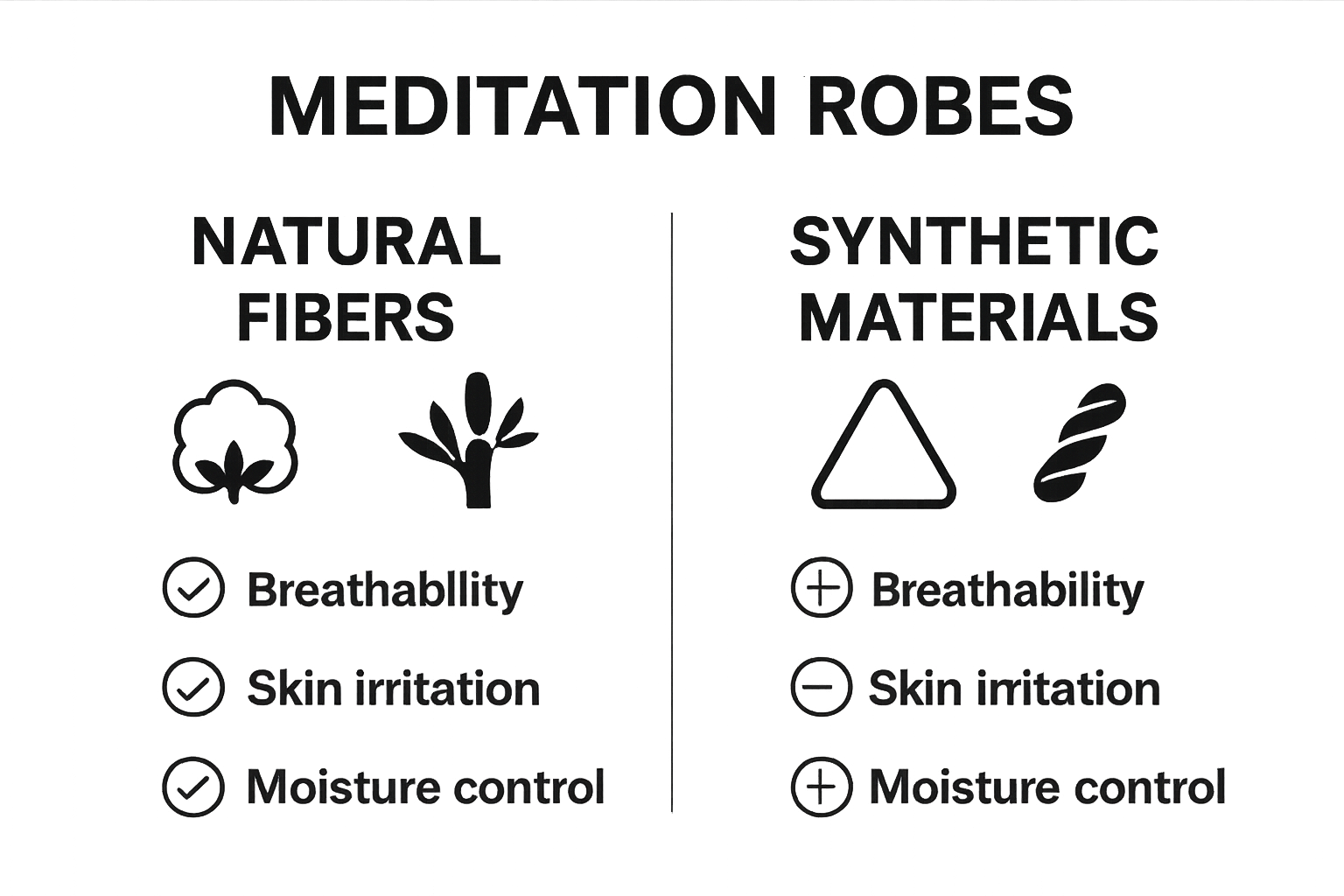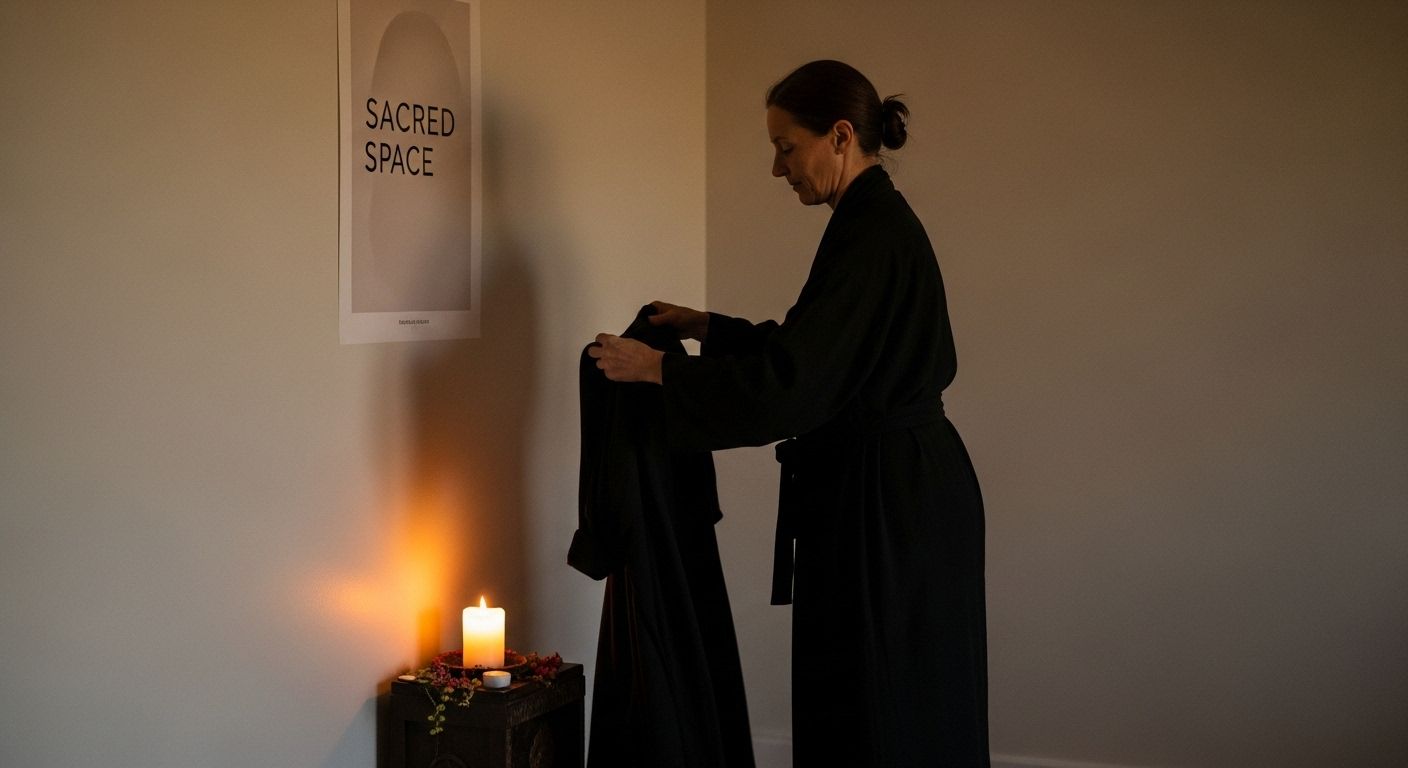
Choosing the right robe for meditation can instantly change how you feel the second it touches your skin. Most people think picking a robe is just about style or color. But studies show the material matters so much that cotton robes reduce skin irritation and discomfort for extended sessions, letting you stay focused much longer. The fabric you wear is more than just clothing and it can actually shape your whole meditation experience in ways you might not expect.
Table of Contents
- The Essence Of Material: Why Choose Comfortable Fabrics?
- Cultural Significance: How Robes Enhance The Meditation Experience
- The Psychological Impact: Creating A Sacred Space With Robes
- Practical Considerations: Selecting The Right Robe For Your Needs
Quick Summary
| Takeaway | Explanation |
|---|---|
| Choose breathable, natural fabrics for comfort | Natural fibers like cotton and bamboo enhance breathability and reduce irritation, improving your meditation experience. |
| Meditation robes serve as psychological tools | Wearing a specific robe signals your brain to transition into a meditative state, enhancing focus and relaxation. |
| Select robes with a loose, non-restrictive fit | A comfortable fit allows for unrestricted movement, minimizing distractions during meditation sessions. |
| Consider temperature regulation in fabric choice | Optimal robes maintain body temperature, preventing overheating and ensuring a comfortable meditation environment. |
| Ritual clothing enhances spiritual commitment | Wearing a meditation robe symbolizes dedication to practice, helping create a mindset conducive to mindfulness and introspection. |
The Essence of Material: Why Choose Comfortable Fabrics?
When exploring wearing robes for meditation, selecting the right fabric becomes a fundamental aspect of creating a serene and supportive experience. The material touching your skin directly influences your comfort, mental state, and overall meditation practice.
Understanding Fabric Interactions with Skin
Fabric selection goes beyond aesthetic appeal. Research from the American Academy of Dermatology highlights that clothing materials significantly impact sensory perception and physical comfort. When wearing robes for meditation, you want a fabric that minimizes distractions and promotes relaxation.
Key considerations for fabric selection include:
- Softness and texture
- Moisture-wicking capabilities
- Breathability
- Thermal regulation
Natural Fibers vs Synthetic Materials
Natural fibers like cotton and bamboo offer unique advantages for meditation wear. These materials provide exceptional breathability and gentle skin contact. According to skin textile research, cotton demonstrates lower skin friction, which translates to reduced irritation and
enhanced comfort during extended meditation sessions.
Synthetic materials, while sometimes more durable, can create unnecessary sensory barriers. They might trap heat, increase sweating, and potentially disrupt your meditative focus. Choosing breathable, natural fabrics allows your body to maintain a balanced temperature and supports a more centered mental state.
To help you easily compare textile options discussed in the article, the following table summarizes the strengths and drawbacks of natural and synthetic fabrics for meditation robes.
| Fabric Type | Key Benefits | Potential Drawbacks |
|---|---|---|
| Cotton | Breathable, soft, reduces irritation | May retain moisture in humid conditions |
| Bamboo | Excellent breathability, soft texture, moisture-wicking | Less common, may be pricier |
| Synthetic (e.g., polyester) | Durable, easy to wash | Traps heat, can increase sweating and irritation |

The ideal meditation robe material should feel like a second skin: present but not restrictive, warm but not overheating, soft but structurally supportive. By prioritizing fabric quality, you transform your meditation attire from mere clothing into a tool for deeper mindfulness and relaxation.
Cultural Significance: How Robes Enhance the Meditation Experience
Meditation robes represent far more than simple clothing. They are profound cultural artifacts that embody spiritual practice, symbolize personal commitment, and create a transformative psychological space for practitioners across different traditions.
Spiritual Symbolism and Personal Transformation
In Buddhist traditions, wearing a meditation robe transcends physical comfort. According to the Metropolitan Museum of Art, the vestment symbolizes deep spiritual transmission. The robe becomes a sacred garment that marks an individual’s commitment to introspective practices and philosophical growth.
Key symbolic representations include:
- Renunciation of material attachments
- Public declaration of spiritual commitment
- Transformation of secular fabric into sacred context
- Personal boundary between everyday life and contemplative practice
Ritual and Psychological Preparation
Meditation robes serve a critical psychological function beyond their aesthetic value. By donning a specific garment, practitioners create a deliberate mental shift. The act of wearing a dedicated robe signals to the brain that it is time to transition from ordinary consciousness to a more meditative state.
Psychological boundaries are crucial in meditation. When you wear a robe specifically designed for practice, you mentally separate yourself from daily distractions. The robe becomes a tangible signal that triggers relaxation, focus, and introspection.
The cultural significance of meditation robes demonstrates how clothing can be more than fabric. It is a bridge between external appearance and internal transformation, helping practitioners cultivate mindfulness, discipline, and spiritual connection through a seemingly simple act of wearing a purposefully designed garment.
The Psychological Impact: Creating a Sacred Space with Robes
Meditation robes function as more than physical garments. They serve as powerful psychological tools that help practitioners transition from everyday consciousness to a deeply reflective internal landscape, transforming ordinary clothing into a gateway for spiritual exploration.
Ritual Clothing as Psychological Transition
Research published in the Royal Society’s scientific journal demonstrates how ritualized practices can significantly reduce physiological stress markers. Wearing a specific meditation robe acts as a deliberate psychological signal, marking a clear boundary between mundane experiences and contemplative practice.
Key psychological transitions triggered by meditation robes include:
- Conscious separation from daily distractions
- Mental preparation for introspective practice
- Activation of mindfulness neural pathways
- Neurological priming for deep relaxation
Creating Intentional Mental Boundaries
The act of putting on a meditation robe becomes a conscious ritual of self-transformation. This intentional dressing process helps practitioners shed external identities and professional roles, creating a mental sanctuary where inner exploration can emerge.
By dedicating specific clothing to meditation, you train your brain to recognize and rapidly enter a state of calm. The robe becomes a sensory trigger that immediately communicates to your nervous system: “It is time to be present, quiet, and reflective.”

Ultimately, meditation robes transcend fabric and design. They are sophisticated psychological instruments that support practitioners in navigating the delicate terrain between external stimulation and internal peace, transforming a simple garment into a powerful tool for mindfulness and self-discovery.
Practical Considerations: Selecting the Right Robe for Your Needs
Choosing a meditation robe involves more than aesthetic preferences. The right garment supports your practice by balancing physical comfort, psychological readiness, and personal spiritual expression.
Understanding Fit and Fabric Dynamics
The American Academy of Dermatology emphasizes the critical importance of clothing selection for comfort and skin health. When selecting a meditation robe, prioritize materials and cuts that promote unrestricted movement and sensory ease.
Key selection criteria include:
- Loose, non-restrictive fit
- 100% natural fiber composition
- Breathable fabric texture
- Minimal seam and tag irritation
Temperature Regulation and Comfort
Optimal meditation robes function like a second skin, maintaining consistent body temperature without causing overheating or excessive cooling. The goal is creating a neutral thermal environment that allows your mind to focus inward without physical distraction.
Consider how different fabric weights and layering techniques can support various meditation environments. A lightweight cotton robe might be perfect for warm studio spaces, while a slightly heavier bamboo blend could provide warmth during early morning or outdoor meditation sessions.
Ultimately, your meditation robe is a personal tool for inner exploration. By selecting a garment that feels like an extension of your intentional practice, you transform a simple piece of clothing into a supportive companion on your spiritual journey.
The following table summarizes important criteria to consider when selecting a meditation robe, helping you identify features that align with both comfort and focused practice.
| Selection Criterion | Why It Matters |
|---|---|
| Loose, non-restrictive fit | Promotes movement and minimizes discomfort |
| 100% natural fiber | Enhances breathability and reduces skin irritation |
| Breathable fabric texture | Prevents overheating, supports longer sessions |
| Minimal seams/tags | Reduces distractions and skin irritation |
| Suitable fabric weight | Allows for comfort across varied environmental temperatures |
Discover Real Comfort for Your Meditation Journey
Are you finding it difficult to build a calming meditation routine because your clothing distracts you or leaves you feeling uncomfortable? As highlighted in “Understanding Wearing Robes for Meditation: Comfort and Calm,” the fabric touching your skin and the fit of your robe play a major role in shaping both your physical comfort and your mental state. When you invest in the right meditation robe, you minimize distractions and create a dedicated space for mindfulness and relaxation.

With Lotus Linen, you can choose from plush, waffle, and customizable robes designed with soft, breathable fabrics and thoughtful finishing. Each robe supports ease of movement, regulates body temperature, and creates that intentional psychological boundary discussed in the article. Ready to turn your meditation practice into a truly soothing ritual? Explore our premium collection today at shoplotuslinen.com and experience a robe that feels like an extension of your calm. Your path to deeper focus and authentic comfort starts now.
Frequently Asked Questions
What materials are best for meditation robes?
Natural fibers like cotton and bamboo are recommended for meditation robes due to their breathability, softness, and comfort against the skin. These materials help minimize distractions and promote relaxation during meditation.
How do meditation robes affect my meditation practice?
Meditation robes can enhance your practice by creating a psychological boundary between daily distractions and contemplative focus. Wearing a dedicated robe signals to your brain that it’s time to enter a meditative state, aiding in relaxation and mindfulness.
What should I consider when choosing the fit of my meditation robe?
Look for a loose, non-restrictive fit that allows for easy movement. Additionally, ensure the robe is made from breathable, natural fibers to maintain comfort and avoid skin irritation during your practice.
Why is the texture of the fabric important for meditation robes?
The texture of the fabric is crucial because it impacts sensory perception and comfort. Soft, smooth textures reduce skin friction and irritations, enabling a more focused and distraction-free meditation experience.



